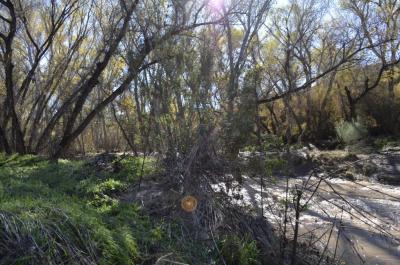Progress Takes Patience – Restoring Water to the Lower San Pedro River
SUMMARY
Linda Qian is communications manager for Intel’s Global Public Affairs & Sustainability organization. Linda is one of several corporate hippies based in Arizona, where she enjoys the mild winters and detests the extremely hot summer months.
My day job as a communications manager sometimes keeps me at my desk for hours on end, so when my colleague Fawn Bergen asked if I’d be up for a site visit to one of our water restoration projects, I jumped at the chance. For the last several years, Fawn has been leading Intel’s efforts to restore 100% of our global water use by funding projects in collaboration with community organizations to restore water to rivers, lakes, and streams near Intel operations.
So last week, I rented a car and drove about 90 minutes southeast through the gorgeous Sonoran Desert to the small Arizona town of Mammoth. My colleague Theresa Niemeyer, who manages our Arizona community engagement program that connects employee volunteers to needs in our local community, joined me on the adventure.
In Mammoth, we met up with conservation leaders from Arizona Land and Water Trust (Trust), hopped into their 4×4, drove a short distance, and pulled onto a scrubby field, where a couple of Arizona Game & Fish employees met up with us to explain how they were working with the Trust to convert about 100 acres of former agricultural fields to native grasses.
Adjacent to the fields is the San Pedro river. The banks of the river, a bosque forest habitat found only in riparian areas near riverbanks in the southwestern United States, provide critical habitat for migratory birds from all across North America and endangered species like the Southwestern Willow Flycatcher. The fields are an IBA, or “Important Bird Area” which is frankly the best acronym I’ve heard this year.
For 50 years, these fields were farmed for cotton and semolina wheat using conventional agricultural methods, pulling water from on-site wells and the adjacent river. I imagined what it must have been like in the summertime, with fields of amber waves of grain, and the Arizona sun beating down strong. But today, as the conversion has slowly taken hold of the earth, the fields are covered in tumbleweeds, native grasses, and forbs (broad-leaved herbs) like silverleaf nightshade with sunny yellow fruits that I assume are poisonous, and even tomatillo, which I’m told I should not eat, even though I want to.
Converting the fields to native grasses has not been without setbacks – we funded the project in 2017 but it’s taken until this year to see real results. The first attempt resulted in canary grass, which is a common invasive species that propagates in former wheat fields. Knowing that further attempts would result in the same, Game & Fish took another route, applying pre-emergent to the fields to clear the seed banks and allow them to plant native seeds like Arizona poppy, globemallow, and penstemon, all of which will use significantly less water, to the tune of 73 million gallons per year. After a couple of seasons, the fields are showing signs of coming around – and so has the wildlife. A rafter of turkeys has settled in, and even a bear has been spotted by wildlife cameras in the bosque.
After a quick and lovely lunch at Aravaipa Farms, Theresa and I hopped back in our car and made our way back to Chandler, where Intel’s high-volume semiconductor factories are producing technology that connects us all. Investing in these water restoration projects is one of the ways we’re making sure we have enough water to keep manufacturing here in Arizona, as we have for nearly 40 years.
Besides being a great excuse to get out of my cube, visiting the project has been a welcome reminder that sometimes, change is slow. Sometimes, you really can’t rush things along – you can only set your plan in motion and let it work itself out.













